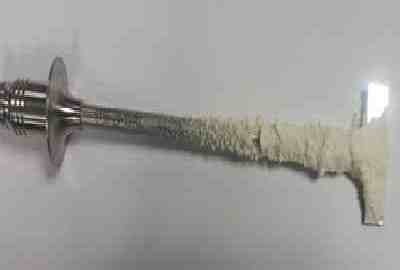Interaction of powder particles with water vapor at certain temperatures can unexpectedly transform free flowing powders into cohesive or even sticky powders. This phenomenon described as powder stickiness can cause all sorts of highly undesired issues during e.g. dosing of powders, storage of powders and even during production, such as in the case of spray drying. Think of sticky powder in spray dryers or sticky product during storage in big bags or hoppers leading to a cake-like structure and as a results poor dosing and flow properties. Powder stickiness, stickiness measurement and prediction thereof is not an easy task. The adhesion and adhesive forces between particles are influenced by a range of variables like particle size, particle shape, porosity, surface properties and of course the chemical nature of the material making stickiness measurement a challenging task.
Prediction of powder stickiness and stickiness measurement is key in preventing above-mentioned problems, but is not an easy assessment since every product will act differently towards variation in relative humidity and temperature of the environment to which the powder is exposed. The intimate relation between temperature and humidity makes predicting even more difficult. Accordingly, dedicated equipment and expertise is required to study this powder stickiness behavior and perform adequate measurement of the stickiness properties.
We have two main instrumental methodologies available for stickiness measurement:
- Water vapor adsorption isotherms at different temperatures and relative humidity of 0-95%. Use of the Guggenheim, Anderson, de Boer (GAB) model can help to determine the stickiness point from the isotherm at each temperature measured, although this is not always straightforward to determine. Stickiness measurements reported in literature have been carried out following this approach, but within Delft Solids Solutions we have developed a novel stickiness measurement methodology.
- Powder rheometry under real time conditions of temperature and relative humidity. Here we directly measure the stickiness point by changes in cohesive forces between particles and thus friction of the powder bed during fluidization upon changes in the powder properties. For this purpose we have greatly amended our powder rheometer to make it capable of stickiness measurement that has not been reported before. Since this stickiness measurement directly detects changes in powder flow by changes in friction it is highly preferred over the vapor adsorption method listed above, which is an indirect stickiness measurement approach.
We have recently published a scientific paper on powder stickiness measurement using the above-listed methodologies; a copy of the paper can be requested via this link.
Combination of the individual sticky points recorded at the different temperatures enables to construct a stickiness diagram using a modified Mollier diagram in which conditions of sticky and non-sticky behaviour can be discriminated and further predicted. Powder stickiness measurement can so be made accessible to you and assist in trouble shooting and product development.

- Powder Flow and Ring Shear Testing
- Unconfined powder flow testing
- Powder Caking by Uni-axial compact strength testing
- Powder stickiness measurement
- Heubach and EN 15051 dustiness analysis
- Attrition and abrasion of particles, granules and tablets
- Segregation testing of powders and solids
- EN 17199-4 Dustiness index and nano particles



